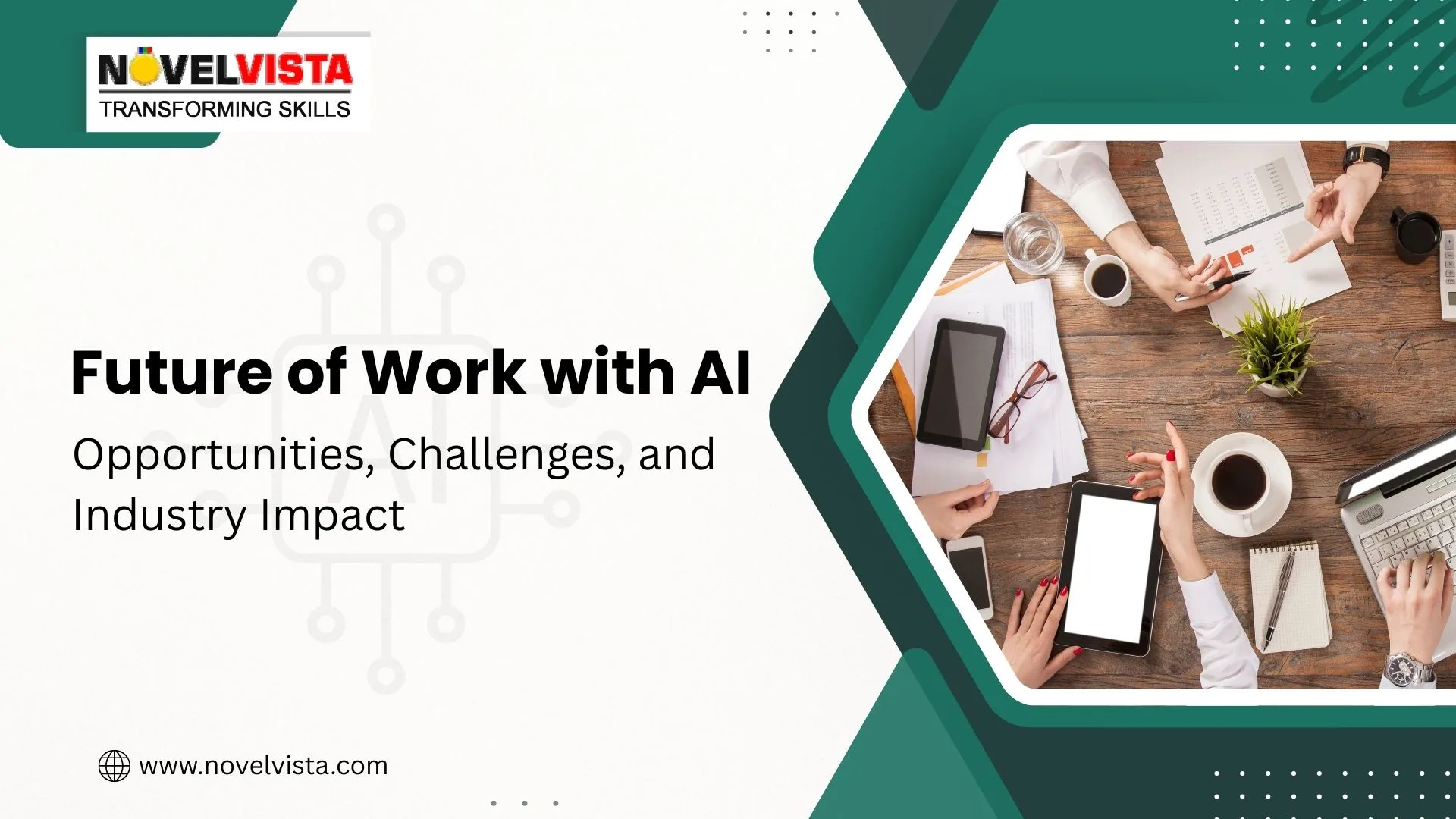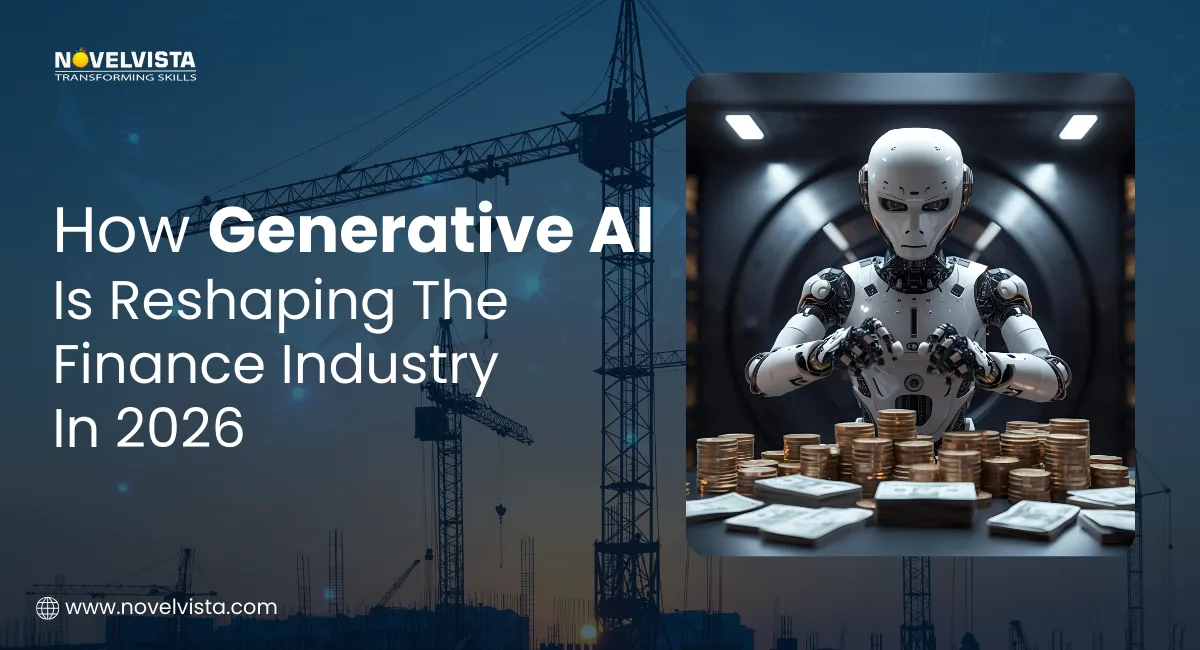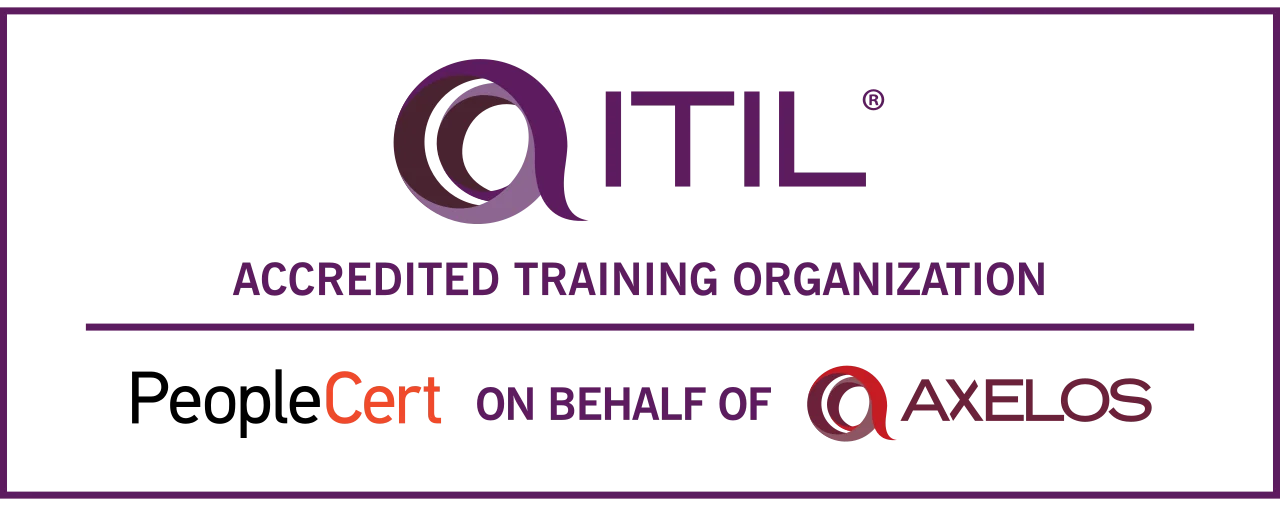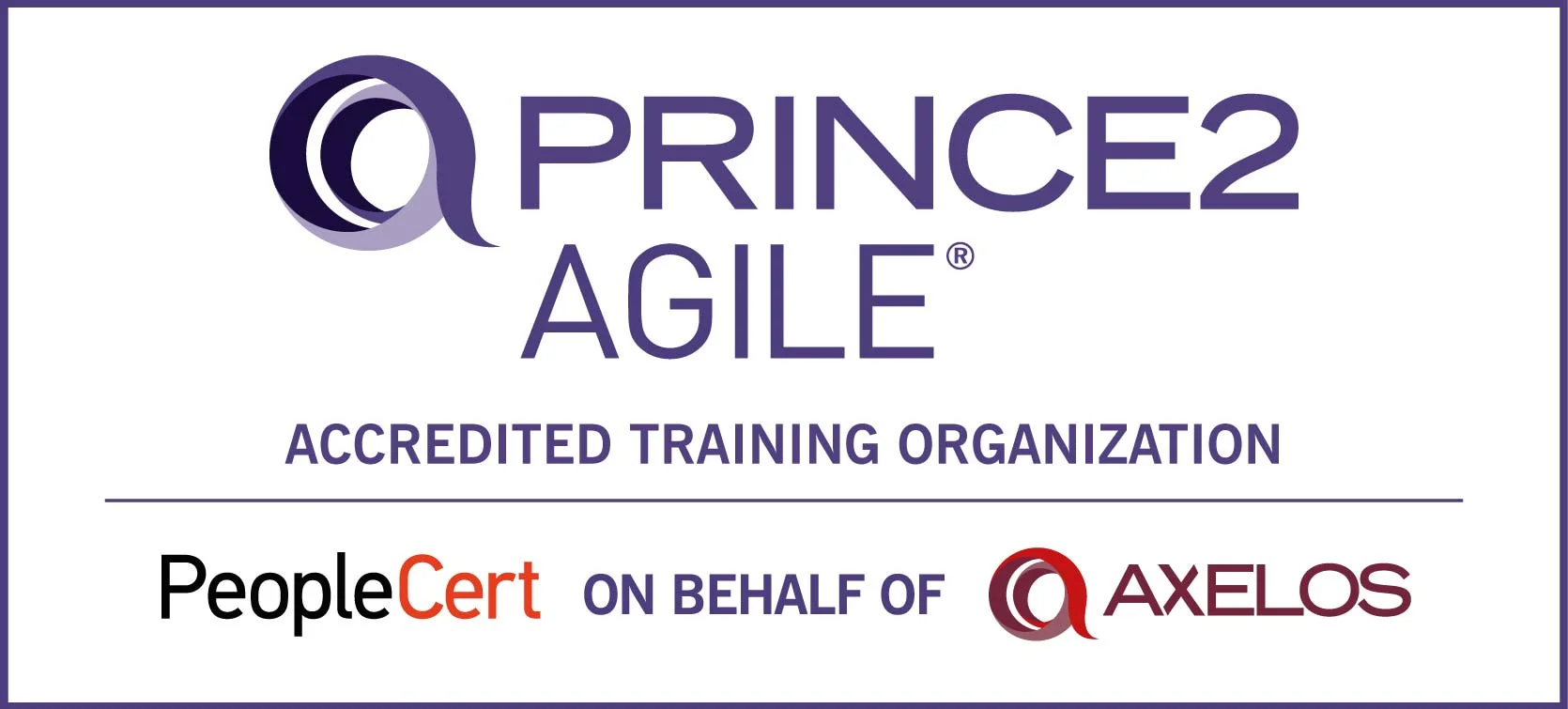- AI in the workplace
- Top AI Technologies Transforming Work and Business
- Benefits of AI for Businesses and Employees
- AI’s Impact on Work
- AI Impact on Different Industries and Sectors
- How Businesses Can Get Ready for AI Adoption
- Key Challenges When Implementing AI at Work
- AI and the Changing Nature of Work
- How NovelVista Can Help You
- Our Suggestion
- Conclusion
Let’s be honest, there’s a lot of noise about AI revolutionizing everything. But for business leaders, HR teams, educators, or even individual professionals, the real questions are far more practical:
- What will AI actually change about my work?
- Will it eliminate jobs or create them?
- How do I get ready?
This blog is your clear-eyed guide to these questions. You’ll learn:
- The key AI technologies transforming workplaces.
- Tangible opportunities and risks for businesses.
- Impacts across sectors, from healthcare to finance.
- Practical strategies for preparing your teams.
AI in the workplace
Artificial Intelligence is no longer a futuristic concept; it’s an operational reality. According to McKinsey (2024), over 50% of organizations worldwide have adopted at least one AI capability.
Role Artificial intelligence in the workplace is growing because of its ability to:
- Automate routine, repetitive tasks.
- Augment human decision-making with advanced analytics.
- Enable entirely new ways of working through intelligent systems.
But the urgency isn’t just technological. It’s economic and strategic. Countries are competing on AI readiness. Industries are rethinking roles and skills. And workers everywhere are grappling with how to stay relevant.
This isn’t an optional transformation. It’s a necessary evolution.
Top AI Technologies Transforming Work and Business
Before planning, you need to know the tools shaping the landscape:
1️. Generative AI
- Tools like ChatGPT, Gemini, and MidJourney are changing content creation, coding assistance, design prototyping, and more.
- Organizations use them to cut turnaround times, improve quality, and unlock creative potential at scale.
2️. AI Assistants
- Chatbots, virtual agents, and productivity tools embedded in apps (e.g., Microsoft Copilot, Google Workspace AI features).
- Streamline customer service, automate scheduling, and even help with drafting communications.
3️. Autonomous AI Agents
- Systems that can plan and execute multi-step tasks with minimal oversight.
- Used in logistics, operations management, and even sales prospecting.
- Early-stage but growing rapidly as organizations seek true automation.
4️. Related Technologies
- Robotics in manufacturing and logistics.
- Predictive analytics in supply chain and finance.
- Computer vision in quality control, healthcare imaging, and retail.
These technologies aren’t standalone; they’re converging to reshape work in layered, complex ways.
Benefits of AI for Businesses and Employees
AI is more than a cost-cutter. Done well, it’s a value generator. Here’s how:
Boosting Productivity
- Automate routine tasks, freeing teams for strategic work.
- For example, AI-powered document summarization can reduce hours of manual reading.
- McKinsey suggests AI could add $2.6–$4.4 trillion annually to global productivity.
Transforming Workflows with Human–AI Collaboration
- AI is not just a worker replacement; it’s a co-pilot.
- Examples:
- Doctors are using AI diagnostics to improve accuracy.
- Marketers are using AI analytics to refine campaigns in real time.
- Doctors are using AI diagnostics to improve accuracy.
Creating New Job Roles and Skills Demand
- AI will displace certain repetitive roles but create others in development, governance, and operations.
- Google’s own analysis points to:
- New roles in AI development, data science, and machine learning.
- Transformed existing roles that demand AI collaboration skills.
- New roles in AI development, data science, and machine learning.
Accelerating Innovation and Insights
- AI can reveal patterns in massive datasets.
- Examples:
- Financial institutions are detecting fraud in real-time.
- Retailers are predicting demand fluctuations.
- Financial institutions are detecting fraud in real-time.
- Faster, better insights mean faster innovation cycles.
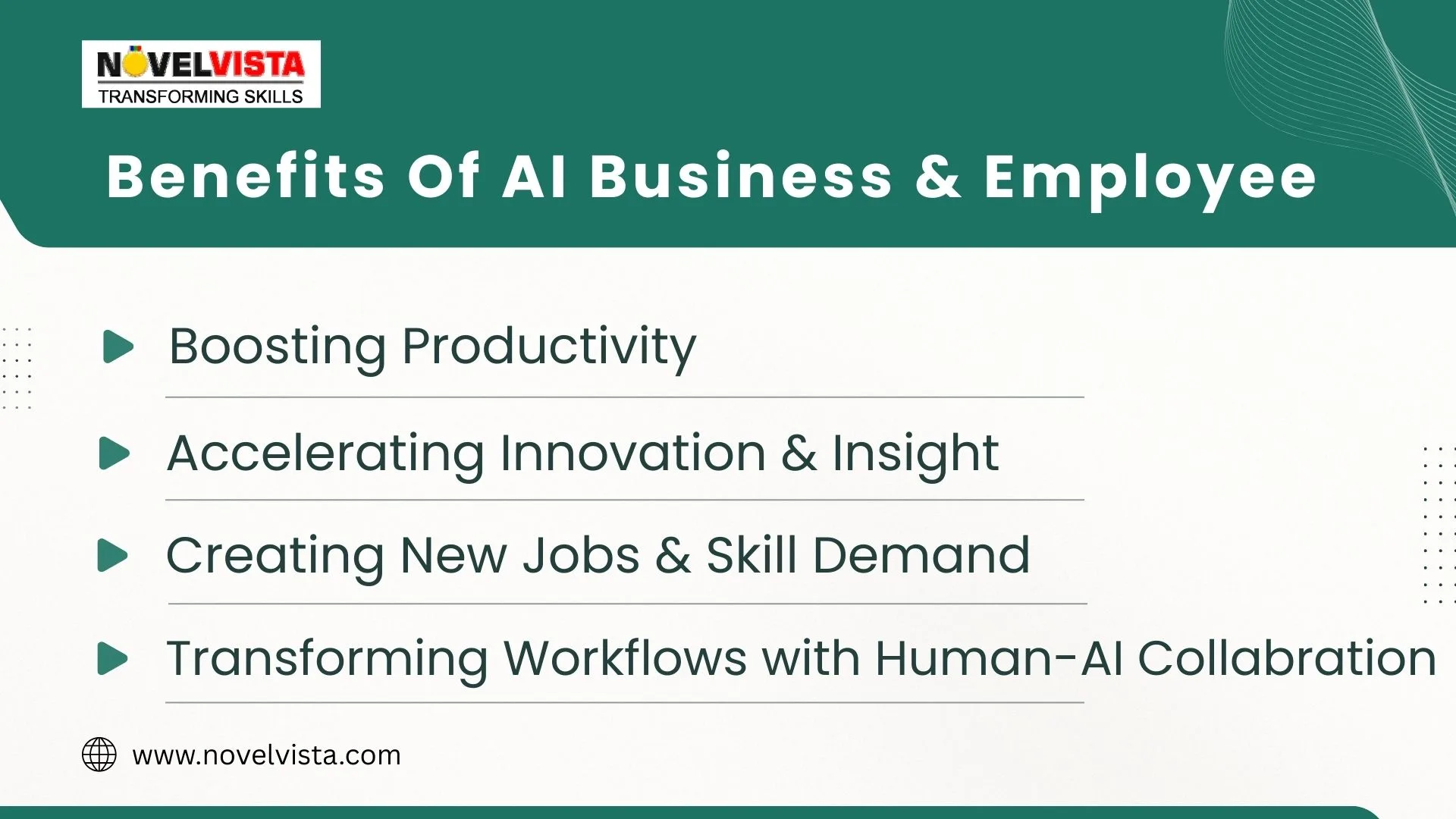
AI’s Impact on Work
Impact on Job Roles
- Automation of Repetitive Tasks: AI-powered systems will automate routine work, potentially displacing some roles, especially in administrative and operational functions.
- Creation of New Roles: Demand will rise for AI engineers, data scientists, and ethical AI specialists.
- Transformation of Existing Roles: Workers will need to adapt and develop new skills to work with AI systems rather than be replaced by them.
Skills for the Future
- Technical Skills: Data analysis, machine learning, AI development, and programming.
- Soft Skills: Critical thinking, problem-solving, communication, creativity, and collaboration.
- Adaptability and Continuous Learning: Workers will need to embrace ongoing learning to stay relevant in a rapidly evolving environment.
AI in the Workplace
- Increased Productivity: Automate tasks, analyze data, and generate insights quickly.
- Improved Decision-Making: Support data-driven strategies.
- Enhanced Job Quality: Reduce monotonous tasks so employees can focus on meaningful work.
Potential Risks
- Job displacement, bias in algorithms, and data privacy concerns.
- Need for responsible, transparent AI development and deployment.
AI Impact on Different Industries and Sectors
AI’s effects aren’t uniform; they vary by sector. Here’s a closer look:
Technology & Finance
- Risk modeling, fraud detection, and automated customer service.
- Predictive analytics for better investment decisions.
- Goldman Sachs estimates AI could increase global GDP by 7% over a decade.
Healthcare
- AI diagnostics, patient monitoring, personalized treatment plans.
- Radiology, pathology, and genomics are seeing rapid AI integration.
- WHO notes AI can improve care delivery but requires ethical guardrails.
Manufacturing & Retail
- Robotics in assembly lines.
- AI-powered supply chain optimization.
- Personalized marketing and improved customer experience.
Public Sector & Services
- Chatbots for citizen engagement.
- Data analytics to improve service delivery.
- Fraud detection in benefits systems.
HR & Education
- AI-driven recruitment and talent management.
- Personalized learning pathways.
- Early intervention through predictive analytics in education systems.
How Businesses Can Get Ready for AI Adoption
Adopting AI isn’t just about buying new software. It’s about reshaping how your organization works and learns. Many firms underestimate this cultural and strategic shift. Here’s how to plan it effectively:
Strategic Alignment with Business Goals
- AI adoption must support your actual business strategy, not just follow trends.
- Define clear objectives: cost savings? Customer experience? Innovation?
- Prioritize use cases with measurable ROI.
Building Robust Data Infrastructure
- AI is only as good as the data feeding it.
- Invest in:
- Data quality initiatives.
- Modern, scalable storage.
- Strong governance and security practices.
- Data quality initiatives.
- Without reliable data, even the best AI will produce poor outcomes.
Investing in Talent Development and Upskilling
Develop structured learning programs focused on:
- Technical skills like data analysis, AI operations, and programming.
- Essential soft skills: problem-solving, creativity, and adaptability.
Encourage continuous learning, not one-time training.
Fostering Ethical AI Use and Cultural Change
- Employees often fear AI will replace them. Transparency is essential.
- Develop clear guidelines for the ethical use of AI:
- Fairness and bias mitigation.
- Privacy and data protection.
- Transparent decision-making.
- Fairness and bias mitigation.
- Build a culture that sees AI as a partner, not a threat.
Planning for Long-Term, Adaptable AI Strategies
- Technology moves fast; your strategy should be adaptable.
- Create cross-functional teams to regularly review:
- New use cases.
- Emerging risks.
- Evolving regulations.
- New use cases.
- Plan for scaling successful pilots organization-wide.
Key Challenges When Implementing AI at Work
AI adoption isn’t a silver bullet. Organizations face significant hurdles they must address with clear eyes and steady hands.
Job Displacement Fears vs. New Roles
- Yes, automation will displace some roles, especially highly repetitive tasks.
- At the same time, AI creates demand for new roles: data scientists, AI ethics officers, and prompt engineers.
- Organizations need to plan for workforce transitions, not simply cost-cutting.
Skills Gap and Upskilling Urgency
- A 2024 IBM study found 40% of the workforce will need reskilling in the next 3 years due to AI.
- Organizations cannot outsource this responsibility; they must invest in training at scale.
Data Quality, Privacy, and Ethical Concerns
- AI models are only as good as their data.
- Poor data quality leads to flawed predictions.
- Privacy laws (GDPR, CCPA) require robust compliance strategies.
- Algorithmic bias is a real risk, requiring responsible development and continuous auditing.
Organizational Resistance and Cultural Hurdles
- Change management is as critical as technology deployment.
- Employees may resist AI out of fear or misunderstanding.
- Leaders must communicate clearly and frequently about purpose, benefits, and guardrails.
Infrastructure and Cost Constraints
- AI adoption isn’t cheap.
- It requires investment in computing resources, data storage, integration, and maintenance.
- ROI may take time, and realistic planning is essential.
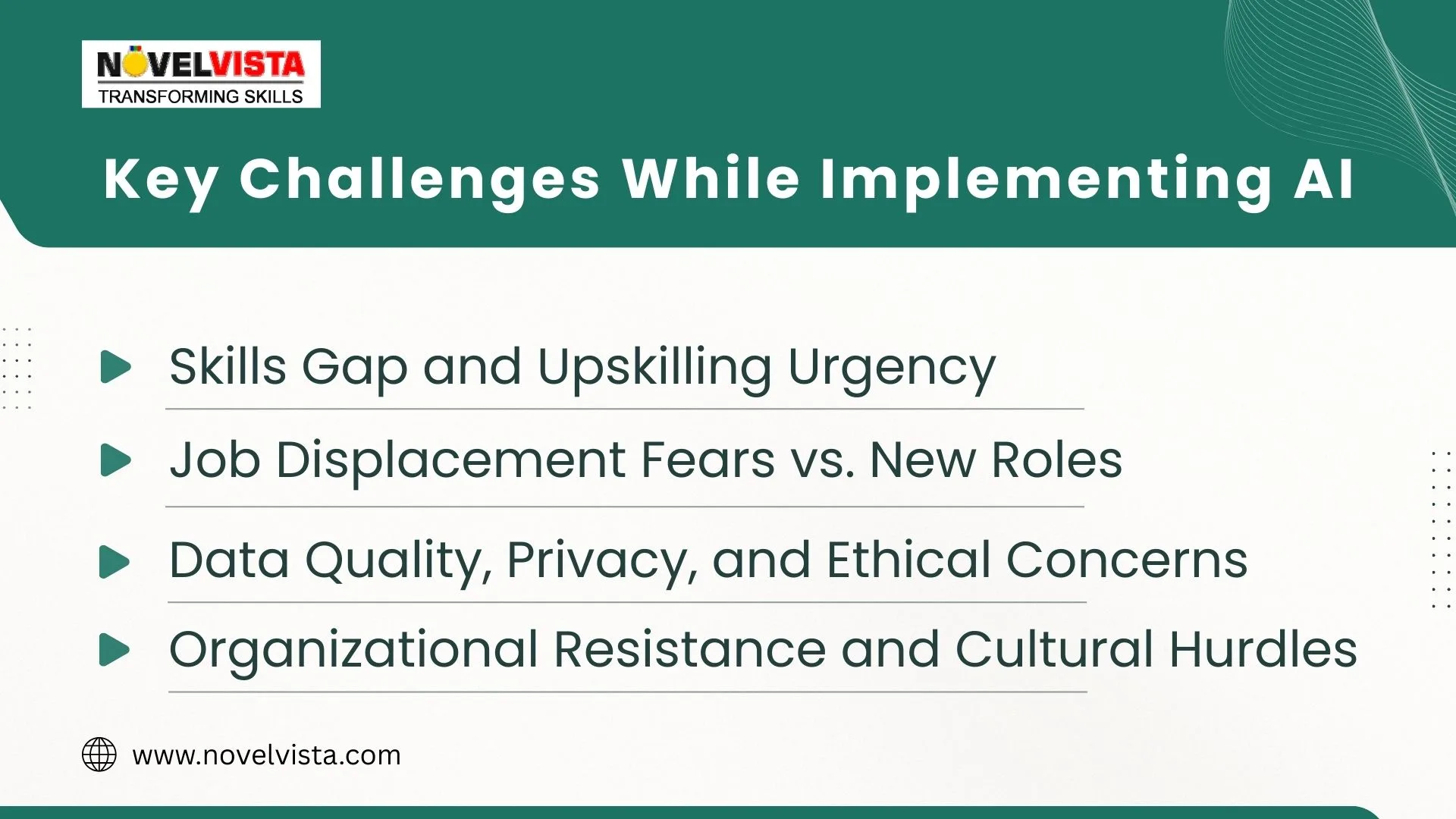
AI and the Changing Nature of Work
Let’s ground this in Google’s own view of AI in the workplace:
Automation of Repetitive Tasks
- AI systems will take over routine tasks, from data entry to scheduling, freeing humans for higher-value work.
- But this also raises the need for job transition plans in affected sectors.
Creation of New Roles
- New opportunities in AI development, data science, ethics, and AI operations.
- Businesses will need to hire or train for these emerging roles.
Transformation of Existing Roles
- Many jobs won’t disappear but will change.
- Employees will need to learn how to work with AI systems effectively.
Skills for the Future
- Technical skills: data analysis, machine learning, programming.
- Soft skills: critical thinking, problem-solving, collaboration.
- Adaptability and a commitment to continuous learning.
Preparing for the Future
- Organizations should invest in robust upskilling programs.
- Foster AI literacy at all levels, so teams can make informed, ethical decisions about adoption.
- Build partnerships across government, academia, and industry to share best practices.
How NovelVista Can Help You
At NovelVista, we understand that adopting AI is more than a technology project; it’s a people strategy.
We help organizations:
- Assess AI readiness and align adoption with strategic goals.
- Design tailored upskilling and reskilling programs that bridge the AI skills gap.
- Build leadership understanding of AI opportunities and ethical considerations.
- Support change management to reduce resistance and build trust.
We don’t just teach what AI is; we enable your teams to use it responsibly, creatively, and profitably
With our global experience and certified trainers, NovelVista empowers organizations of all sizes to turn AI challenges into competitive advantages.
Free Download: Future-Proof Your Career in the Age of AI!
Discover how AI is transforming jobs—and how you can stay ahead.
Our Suggestion
AI is already reshaping the way the world works. The choice isn’t whether to adopt it, but how to adopt it well.
We suggest you:
- Start with a clear, business-aligned strategy.
- Invest in building a robust data foundation.
- Prioritize people: train them, support them, and empower them to work with AI.
- Plan for continuous evolution, not one-off deployment.
And if you’re looking for a partner on that journey, someone to guide your teams from confusion to confidence, we’re here to help.
Conclusion
The Ai and the future of work isn’t a dystopian nightmare or a frictionless utopia. It’s a complex, evolving reality that demands thoughtful leadership, continuous learning, and bold yet careful planning.
Organizations that see Generative AI Professional as a collaborator rather than a competitor will unlock new levels of productivity, creativity, and growth.
Workers who embrace continuous learning and develop both technical and human skills will thrive in this new landscape.
Let’s shape a future of work where AI amplifies our human strengths, not replaces them. It’s time to plan, act, and lead with vision.
Frequently Asked Questions
Author Details

Akshad Modi
AI Architect
An AI Architect plays a crucial role in designing scalable AI solutions, integrating machine learning and advanced technologies to solve business challenges and drive innovation in digital transformation strategies.
Course Related To This blog
Certified Generative AI in ITSM
Generative AI Professional
Generative AI in Finance and Banking
Generative AI in Cybersecurity
Generative AI in Business
Confused About Certification?
Get Free Consultation Call

